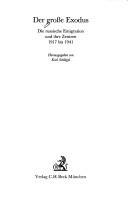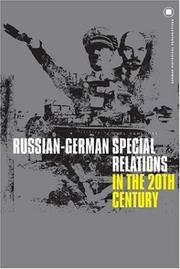| Listing 1 - 10 of 29 | << page >> |
Sort by
|
Book
ISBN: 3110446642 3486704451 Year: 2011 Publisher: De Gruyter
Abstract | Keywords | Export | Availability | Bookmark
 Loading...
Loading...Choose an application
- Reference Manager
- EndNote
- RefWorks (Direct export to RefWorks)
Die Rede vom "russischen Raum" bezieht sich nicht nur auf ein Stereotyp, sondern auf eine empirische Erfahrung, der die Weite und Größe Russlands - ob nun als Russisches Reich, Sowjetunion oder Russländische Förderation - zugrundeliegen. Dabei geht es nie nur um die physisch-geographische Ausdehnung eines Territoriums, sondern um die Implikationen eines spezifischen Raumes für den Verlauf von Geschichte, nicht zuletzt für die "Topographie der russischen Seele" (Nikolaj Berdjaev). In der Vergangenheit ist der Diskurs zum "russischen Raum" - wenn überhaupt - vorwiegend in völkerpsychologischen, essentialistischen und deterministischen Kategorien geführt worden. Der epochale Vorgang der Auflösung der Sowjetunion einerseits und die neue Aufmerksamkeit für die räumliche Dimension geschichtlichen Geschehens andererseits eröffnen eine Perspektive, in der Raum und Raumbewältigung als Probleme russischer Geschichte neu gedacht werden können. Mit Beiträgen von Mark Bassin, Oksana Bulgakowa, Roland Cvetkovski, Susi K.Frank, Klaus Gestwa, Carsten Goehrke, Wladislaw Hedeler, Katharina Kucher, Christian Noack, Susan E.Reid, Frithjof Benjamin Schenk, Karl Schlögel.
Geschichte. --- Historisches Kolleg. --- Russische Geschichte. --- Spatial turn. --- HISTORY / General.
Book
ISBN: 9783938593233 3938593237 Year: 2014 Volume: 99 Publisher: München Carl Friedrich von Siemens Stiftung
Abstract | Keywords | Export | Availability | Bookmark
 Loading...
Loading...Choose an application
- Reference Manager
- EndNote
- RefWorks (Direct export to RefWorks)
Political philosophy. Social philosophy --- History of Eastern Europe --- anno 1900-1999 --- Russian Federation --- Russia --- Communism --- Social aspects. --- Soviet Union --- Communist countries --- Civilization. --- History
Book
ISBN: 9789045000602 9045000601 Year: 2008 Publisher: Amsterdam Atlas
Abstract | Keywords | Export | Availability | Bookmark
 Loading...
Loading...Choose an application
- Reference Manager
- EndNote
- RefWorks (Direct export to RefWorks)
Essays en reportages over maatschappelijke en culturele veranderingen in Oost-Europese steden voor en na de Wende van 1989.
History of Europe --- Regional documentation --- Eastern and Central Europe --- Steden. --- Oost-Europa. --- Cities and towns --- Europe [Central ] --- History --- Europe [Eastern ]

ISBN: 3406386563 Year: 1994 Publisher: München Beck
Abstract | Keywords | Export | Availability | Bookmark
 Loading...
Loading...Choose an application
- Reference Manager
- EndNote
- RefWorks (Direct export to RefWorks)
Political refugees --- Soviet Union --- Emigration and immigration

ISBN: 1282545620 9786612545627 1847883176 9781847883179 9781845201777 9781847883179 1845201779 Year: 2006 Volume: 19 Publisher: Oxford New York, NY Berg
Abstract | Keywords | Export | Availability | Bookmark
 Loading...
Loading...Choose an application
- Reference Manager
- EndNote
- RefWorks (Direct export to RefWorks)
Examines Russia and Germany's turbulent relationship, including the pre-1914 era of exchange and cooperation; the projects of modernity in post-revolutionary Russia and Weimar Germany; the struggle for dominance over Central Europe in World War II; and mutual views of Germans and Russians after 1945.
Germany -- Foreign relations -- 20th century. --- Germany -- Foreign relations -- Russia. --- Germany -- Foreign relations -- Soviet Union. --- Russia -- Foreign relations -- 20th century. --- Russia -- Foreign relations -- Germany. --- Soviet Union -- Foreign relations -- Germany. --- Germany --- Regions & Countries - Europe --- History & Archaeology --- International relations. --- Russia --- Soviet Union --- Foreign relations --- Coexistence --- Foreign affairs --- Foreign policy --- Global governance --- Interdependence of nations --- International affairs --- Peaceful coexistence --- World order --- Weimar Republic --- Germanii︠a︡ --- Германия --- BRD --- FRN --- Jirmānīya --- جرمانيا --- Nimechchyna --- Gjermani --- Federalʹna Respublika Nimechchyny --- Veĭmarskai︠a︡ Respublika --- Ashkenaz --- Germanyah --- Bundesrepublik Deutschland --- Federal Republic of Germany --- Deutschland --- Repoblika Federalin'i Alemana --- República Federal de Alemania --- Alemania --- República de Alemania --- Bu̇gd Naĭramdakh German Uls --- Kholboony Bu̇gd Naĭramdakh German Uls --- KhBNGU --- ХБНГУ --- German Uls --- Germania --- Republika Federal Alemmana --- Deutsches Reich --- Grossdeutsches Reich --- Weimarer Republik --- Vācijā --- Russie --- Rossīi︠a︡ --- Rossīĭskai︠a︡ Imperīi︠a︡ --- Russia (Provisional government, 1917) --- Russia (Vremennoe pravitelʹstvo, 1917) --- Russland --- Ṛusastan --- Russia (Tymchasovyĭ uri︠a︡d, 1917) --- Russian Empire --- Rosja --- National security --- Sovereignty --- World politics --- Germany (Territory under Allied occupation, 1945-1955) --- Germany (Territory under Allied occupation, 1945-1955 : British Zone) --- Germany (Territory under Allied occupation, 1945-1955 : French Zone) --- Germany (Territory under Allied occupation, 1945-1955 : Russian Zone) --- Germany (Territory under Allied occupation, 1945-1955 : U.S. Zone) --- Germany (East) --- Germany (West) --- Holy Roman Empire --- Russian S.F.S.R. --- Russia (Territory under White armies, 1918-1920) --- ドイツ --- Doitsu --- ドイツ連邦共和国 --- Doitsu Renpō Kyōwakoku --- ドイツ レンポウ キョウワコク --- Allemagne --- URSS --- Relations extérieures --- Deguo --- 德国 --- Gėrman --- Герман Улс
Book
ISBN: 9781789140200 9781780239781 9781789146776 Year: 2018 Publisher: London Reaktion Books
Abstract | Keywords | Export | Availability | Bookmark
 Loading...
Loading...Choose an application
- Reference Manager
- EndNote
- RefWorks (Direct export to RefWorks)
Ukraine is a country caught in a political tug of war: looking East to Russia and West to the European Union, this pivotal nation has long been a pawn in a global ideological game. And since Russia's annexation of Crimea in March 2014 in response to the Ukrainian Euromaidan protests against oligarchical corruption, the game has become one of life and death. In Ukraine: A Nation on the Borderland, Karl Schlögel presents a picture of a country which lies on Europe's borderland and in Russia's shadow. In recent years, Ukraine has been faced, along with Western Europe, with the political conundrum resulting from Russia's actions and the ongoing Information War. As well as exploring this present-day confrontation, Schlögel provides detailed, fascinating historical portraits of a panoply of Ukraine's major cities: Lviv, Odessa, Czernowitz, Kiev, Kharkov, Donetsk, Dnepropetrovsk, and Yalta—cities whose often troubled and war-torn histories are as varied as the nationalities and cultures which have made them what they are today, survivors with very particular identities and aspirations. Schlögel feels the pulse of life in these cities, analyzing their more recent pasts and their challenges for the future.
History of Eastern Europe --- anno 1900-1999 --- anno 2000-2009 --- anno 2010-2019 --- Ukraine
Book
ISBN: 9780691183749 0691183740 9780691232386 Year: 2023 Publisher: Princeton, N.J. Princeton University Press
Abstract | Keywords | Export | Availability | Bookmark
 Loading...
Loading...Choose an application
- Reference Manager
- EndNote
- RefWorks (Direct export to RefWorks)
"The Soviet Union is gone, but its ghostly traces remain, not least int he material vestiges left behind in its turbulent wake. What was it really like to live in the USSR? What did it look. fell smell, and sound like? In The Soviet Century, Karl Schlögel, one of the world's leading historians of the Soviet Union, presents a spellbinding epic that brings to life the everyday world of a unique lost civilization. A museum of--and travel guide to--the Soviet past, The Soviet Century explores i evocative detail both the largest and smallest aspects of life int he USSR, from the Gulag, the planned economy, the railway system, and the steel city of Magnitogorsk to cookbooks, military medals, prison camp tattoos, and the ubiquitous perfume Red Moscow. The book examines iconic aspects of Soviet life, including long queues outside shops, cramps communal apartments, parades, and the Lenin mausoleum, as well as less famous but important parts of the USSR, including the Great Soviet Encyclopedia, the voice of Radio Moscow, graffiti, and even the typical toilet, which became a pervasive social and cultural topic. Throughout, the book shows how Soviet life simultaneously combined utopian fantasies, humdrum routine, and a pervasive terror symbolized by the Lubyanka, then as now the headquarters of the secret police. Drawing on Schlögel's decades of travel in the Soviet and post-Soviet world, and featuring more than 8- illustrations, The Soviet Century is vivid, immediate, and grounded in firsthand encounters with the places and objects it describes. The result in an unforgettable account of the Soviet Century.
Communism and culture --- Quality of life --- Soviet Union --- Civilization --- Social life and customs --- Social conditions --- History of Eastern Europe --- anno 1900-1999 --- Russia --- Material culture --- Civilisation --- Moeurs et coutumes --- Communisme et culture --- Social life and customs. --- Social conditions.

ISBN: 3446202358 Year: 2002 Publisher: München : Hanser Verlag,
Abstract | Keywords | Export | Availability | Bookmark
 Loading...
Loading...Choose an application
- Reference Manager
- EndNote
- RefWorks (Direct export to RefWorks)
Book
ISBN: 9783596177868 Year: 2009 Publisher: Frankfurt am Main : Fischer Taschenbuch Verlag,
Abstract | Keywords | Export | Availability | Bookmark
 Loading...
Loading...Choose an application
- Reference Manager
- EndNote
- RefWorks (Direct export to RefWorks)
Book
ISBN: 9783446236554 Year: 2010 Publisher: München : Hanser,
Abstract | Keywords | Export | Availability | Bookmark
 Loading...
Loading...Choose an application
- Reference Manager
- EndNote
- RefWorks (Direct export to RefWorks)
Architecture --- History --- Moscow (Russia) --- Intellectual lif.
| Listing 1 - 10 of 29 | << page >> |
Sort by
|

 Search
Search Feedback
Feedback About UniCat
About UniCat  Help
Help News
News